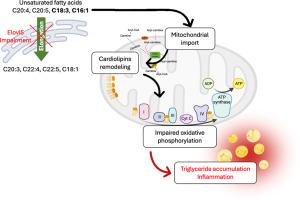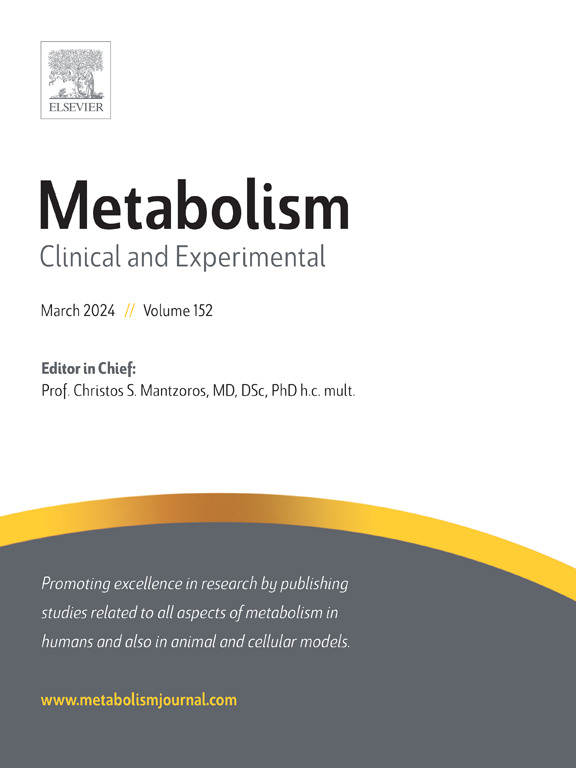Impaired unsaturated fatty acid elongation alters mitochondrial function and accelerates metabolic dysfunction-associated steatohepatitis progression
IF 10.8
1区 医学
Q1 ENDOCRINOLOGY & METABOLISM
引用次数: 0
Abstract
Background and aims
Although qualitative and quantitative alterations in liver Polyunsaturated Fatty Acids (PUFAs) are observed in MASH in humans, a causal relationship of PUFAs biosynthetic pathways is yet to be clarified. ELOVL5, an essential enzyme in PUFA elongation regulates hepatic triglyceride metabolism. Nonetheless, the long-term consequences of elongase disruption, particularly in murine models of MASH, have not been evaluated.
Approach & results
In humans, transcriptomic data indicated that PUFAs biosynthesis enzymes and notably ELOVL5 were induced during MASH progression. Moreover, gene module association determination revealed that ELOVL5 expression was associated with mitochondrial function in both humans and mice. WT and Elovl5-deficient mice were fed a high-fat, high-sucrose (HF/HS) diet for four months. Elovl5 deficiency led to limited systemic metabolic alterations but significant hepatic phenotype was observed in Elovl5−/− mice after the HF/HS diet, including hepatomegaly, pronounced macrovesicular and microvesicular steatosis, hepatocyte ballooning, immune cell infiltration, and fibrosis. Lipid analysis confirmed hepatic triglyceride accumulation and a reshaping of FA profile. Transcriptomic analysis indicated significant upregulation of genes involved in immune cell recruitment and fibrosis, and downregulation of genes involved in oxidative phosphorylation in Elovl5−/− mice. Alterations of FA oxidation and energy metabolism were confirmed by non-targeted metabolomic approach. Analysis of mitochondrial function in Elovl5−/− mice showed morphological alterations, qualitative cardiolipin changes with an enrichment in species containing shorter unsaturated FAs, and decreased activity of I and III respiratory chain complexes.
Conclusion
Enhanced susceptibility to diet-induced MASH and fibrosis in Elovl5−/− mice is intricately associated with disruptions in mitochondrial homeostasis, stemming from a profound reshaping of mitochondrial lipids, notably cardiolipins.

不饱和脂肪酸伸长受损会改变线粒体功能,加速代谢功能障碍相关性脂肪性肝炎的进展。
背景和目的:尽管在人类 MASH 中观察到肝脏多不饱和脂肪酸(PUFAs)的定性和定量改变,但多不饱和脂肪酸生物合成途径的因果关系尚未明确。ELOVL5 是 PUFA 延长过程中的一个重要酶,它调节肝脏甘油三酯的代谢。然而,人们尚未评估破坏伸长酶的长期后果,尤其是在小鼠 MASH 模型中:在人体中,转录组数据表明,在 MASH 进展过程中,PUFAs 生物合成酶,特别是 ELOVL5 被诱导。此外,基因模块关联测定显示,在人类和小鼠中,ELOVL5 的表达与线粒体功能有关。用高脂肪、高蔗糖(HF/HS)饮食喂养 WT 小鼠和 Elovl5 缺乏小鼠四个月。Elovl5 缺乏导致的全身代谢改变有限,但在 Elovl5-/- 小鼠中观察到高脂/高糖饮食后出现了显著的肝脏表型,包括肝肿大、明显的大泡和小泡脂肪变性、肝细胞气球化、免疫细胞浸润和纤维化。脂质分析证实了肝脏甘油三酯的积累和脂肪酸谱的重塑。转录组分析表明,在Elovl5-/-小鼠体内,参与免疫细胞招募和纤维化的基因明显上调,参与氧化磷酸化的基因下调。非靶向代谢组学方法证实了脂肪酸氧化和能量代谢的改变。对Elovl5-/-小鼠线粒体功能的分析表明,线粒体形态发生了改变,心磷脂发生了定性变化,含有较短不饱和脂肪酸的种类增多,I和III呼吸链复合物的活性降低:结论:Elovl5-/-小鼠对饮食诱导的MASH和纤维化的易感性增强与线粒体稳态的破坏密切相关,而线粒体脂质(尤其是心磷脂)的深刻变化则是线粒体稳态破坏的根源。
本文章由计算机程序翻译,如有差异,请以英文原文为准。
求助全文
约1分钟内获得全文
求助全文
来源期刊

Metabolism: clinical and experimental
医学-内分泌学与代谢
CiteScore
18.90
自引率
3.10%
发文量
310
审稿时长
16 days
期刊介绍:
Metabolism upholds research excellence by disseminating high-quality original research, reviews, editorials, and commentaries covering all facets of human metabolism.
Consideration for publication in Metabolism extends to studies in humans, animal, and cellular models, with a particular emphasis on work demonstrating strong translational potential.
The journal addresses a range of topics, including:
- Energy Expenditure and Obesity
- Metabolic Syndrome, Prediabetes, and Diabetes
- Nutrition, Exercise, and the Environment
- Genetics and Genomics, Proteomics, and Metabolomics
- Carbohydrate, Lipid, and Protein Metabolism
- Endocrinology and Hypertension
- Mineral and Bone Metabolism
- Cardiovascular Diseases and Malignancies
- Inflammation in metabolism and immunometabolism
 求助内容:
求助内容: 应助结果提醒方式:
应助结果提醒方式:


